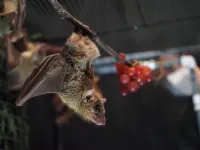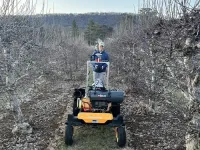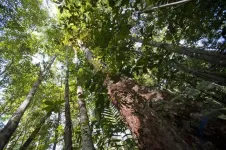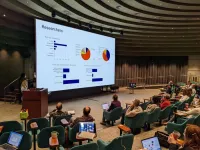(Press-News.org) COLUMBUS, Ohio – In a new study, scientists have discovered that viruses that infect microbes contribute to climate change by playing a key role in cycling methane, a potent greenhouse gas, through the environment.
By analyzing nearly 1,000 sets of metagenomic DNA data from 15 different habitats, ranging from various lakes to the inside of a cow’s stomach, researchers found that microbial viruses carry special genetic elements for controlling methane processes, called auxiliary metabolic genes (AMGs). Depending on where the organisms dwell, the number of these genes can vary, suggesting that viruses’ potential impact on the environment also varies based on their habitat.
This discovery adds a vital piece to better understanding how methane interacts and moves within different ecosystems, said ZhiPing Zhong, lead author of the study and a research associate at the Byrd Polar and Climate Research Center at The Ohio State University.
“It’s important to understand how microorganisms drive methane processes,” said Zhong, also a microbiologist whose research examines how microbes evolve in diverse environments. “Microbial contributions to methane metabolic processes have been studied for decades, but research into the viral field is still largely under-investigated and we want to learn more.”
The study was published today (Feb. 29, 2024) in Nature Communications.
Viruses have helped foster all of Earth’s ecological, biogeochemical and evolutionary processes, but it’s only relatively recently that scientists have begun exploring their ties to climate change. For example, methane is the second-biggest driver of greenhouse gas emissions after carbon dioxide, but is largely produced by unicellular organisms called archaea.
“Viruses are the most abundant biological entity on earth,” said Matthew Sullivan, co-author of the study and a professor of microbiology at the Center of Microbiome Science at Ohio State. “Here, we expanded what we know about their impacts by adding methane cycling genes to the long list of virus-encoded metabolic genes. Our team sought to answer how much of the ‘microbial metabolism’ viruses are actually manipulating during infection.”
Though the vital role microbes play in accelerating atmospheric warming is now well-recognized, little is known about how methane metabolism-related genes encoded by the viruses that infect these microbes influence their methane production, said Zhong. Solving this mystery is what led Zhong and his colleagues to spend nearly a decade collecting and analyzing microbial and viral DNA samples from unique microbial reservoirs.
One of the most important places the team chose to study is Vrana Lake, part of a protected nature reserve in Croatia. Inside the methane-rich lake sediment, researchers found an abundance of microbial genes that affect methane production and oxidation. Additionally, they discovered diverse viral communities and uncovered 13 types of AMGs that help regulate the metabolisms of their host. Despite this, there isn’t any evidence that these viruses directly encode methane metabolism genes themselves, suggesting that viruses’ potential impact on the methane cycling varies by their habitat, said Zhong.
Overall, the study revealed that a higher number of methane metabolism AMGs are more likely to be found inside host-associated environments like the inside of a cow’s stomach, whereas fewer of these genes were found in environmental habitats, such as in lake sediment. Since cows and other livestock are also responsible for generating about 40% of global methane emissions, their work suggests the complex relationship between viruses, living beings and the environment as a whole may be more intricately tied together than scientists once thought.
“These findings suggest that global impacts from viruses are underestimated, and deserve more attention,” said Zhong.
Though it’s unclear whether human activities might have affected the evolution of these viruses, the team expects new insights gleaned from this work will raise awareness about the power of infectious agents to inhabit all life on Earth. Still, to keep learning more about these viruses’ inner mechanisms, further experiments will be needed to understand more about their contributions to Earth’s methane cycle, said Zhong, especially as scientists work toward ways to mitigate microbially driven methane emission.
“This work is a beginning step for grasping the viral impacts of climate change,” he said. ‘We still have lots more to learn.”
This work was supported by the National Science Foundation, the Croatian Science Foundation, the Gordon and Betty Moore Foundation, the Heising-Simons Foundation, the European Union and the U.S. Department of Energy. Co-authors include Jingjie Du of Ohio State, as well as Stephan Kostlbacher and Petra Pjevac from the University of Vienna, and Sandi Orlić from the Ruđer Bošković Institute.
#
Contacts: ZhiPing Zhong, Zhong.393@osu.edu
Matthew Sullivan, Sullivan.948@osu.edu
Written by: Tatyana Woodall, Woodall.52@osu.edu
END
A new paper published in The Quarterly Review of Biology examines the possible effects of two properties of receiver playing fields documented in studies of animal psychology—habituation and neural adaptation—on the efficacy of mate choice signals.
In “A Bridge between Animal Psychology and Sexual Selection: Possible Effects of Habituation and Neural Adaptation on Mate Choice Signals,” William G. Eberhard notes that researchers have paid little attention to habituation and neural adaptation in relation to sexual selection.
Eberhard argues in favor of adding further dimensions to studies of female choice, noting that standard ...
International research co-authored by Joshua Fisher, associate professor in Chapman University’s Schmid College of Science and Technology, suggests that studying root function in tropical forests could help vegetation models improve predictions of climate change. Their study was published on Feb. 28 in New Phytologist.
When it comes to understanding climate change, vegetation models are vital tools that help scientists study plants’ adaptation strategies to changing environmental conditions, including drying, warming and elevated carbon ...
The vocalizations of humans, bats, whales, seals and songbirds vastly differ from each other. Humans and birds, for example, are separated by some 300 million years of evolution. But scientists studying how these animals learn to "speak" have time and again seen surprising similarities in the connections in brain regions that support this vocal learning.
In a paper published in the journal Science, a multi-institutional team led by scientists at Carnegie Mellon University and the University of California, ...
Of the 38 million Americans who have diabetes at least 90% have Type 2, according to the Centers for Disease Control and Prevention. Type 2 diabetes occurs over time and is characterized by a loss of the cells in the pancreas that make the hormone insulin, which helps the body manage sugar.
These cells make another protein, called islet amyloid polypeptide or IAPP, which has been found clumped together in many Type 2 diabetes patients. The formation of IAPP clusters is comparable to how a protein in the brains of Alzheimer's disease patients sticks together to eventually form the signature plaques associated with that ...
UNIVERSITY PARK, Pa. — Spring frosts can have devastating effects on apple production, and a warming climate may be causing trees to blossom early, making them more susceptible to the damaging effects of extreme cold events. Growers’ attempts to prevent the flowers from freezing by attempting to heat the canopies of their orchards largely have been inefficient.
To deal with the worsening problem, Penn State researchers devised a frost protection cyber-physical system, which makes heating decisions based on real-time temperature and wind-direction data. The system consists of a temperature-sensing device, a propane-fueled heater that ...
New York City ranks in the top 15 percent safest of more than 800 U.S. cities, according to a pioneering new analysis from researchers at NYU Tandon School of Engineering, suggesting the effectiveness of the city’s efforts to mitigate homicides there.
In a paper published in Nature Cities, a research team explored the role that population size of cities plays on the incidences of gun homicides, gun ownership and licensed gun sellers.
The researchers found that none of these quantities vary linearly with the population size. ...
In a landmark study, researchers at University of Washington and The Jackson Laboratory have characterized, in exacting detail, the rapid series of events that transform a single fertilized cell into a living, complex being. The work, reported this month in Nature, not only has enabled the team to explore which genes drive the differentiation of hundreds of cell types, but also shows, for the first time, that there are very rapid changes in genetic activity within the hour immediately following birth, underscoring the speed with which newborns must adapt.
“The ...
Tropical trees are at the heart of this study. They are essential for climate regulation, maintaining biodiversity and providing crucial resources for many local communities. Understanding how they evolve genetically is therefore of vital importance for preserving biological diversity and finding sustainable solutions for tropical forest adaptation to the environmental pressures they face.
The aim of this study was to identify the mutations accumulated during growth by two specimens of tropical trees sampled in French Guiana, a French overseas department covered to 96% by tropical forest. To do this, the scientists ...
EMBARGOED FOR RELEASE UNTIL 4 P.M. ET, THURSDAY, FEBRUARY 29, 2024
MINNEAPOLIS – Pedaling on a stationary bicycle built for two may improve the health and well-being for both people with Parkinson’s disease and their care partners, according to a small, preliminary study released today, February 29, 2024, that will be presented at the American Academy of Neurology’s 76th Annual Meeting taking place April 13–18, 2024, in person in Denver and online.
“Our study found that a unique cycling program that pairs people with Parkinson’s disease with their care partners can improve ...
Preprints raise possibility of rethinking the peer-review process as they become more widely used and accepted – new article encourages their growing momentum and provides recommendations to empower researchers to provide open and constructive peer review for preprints
#####
In your coverage, please use this URL to provide access to the freely available paper in PLOS Biology: http://journals.plos.org/plosbiology/article?id=10.1371/journal.pbio.3002502
Article Title: Recommendations for accelerating ...




